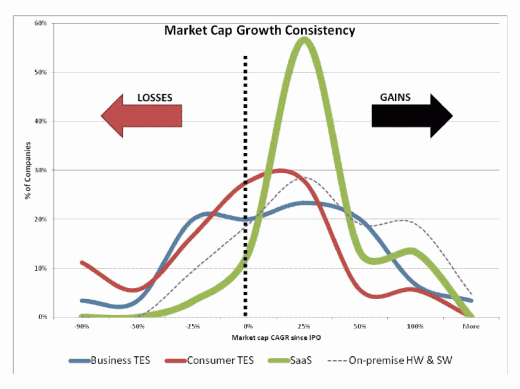
According to a study by Emergence Capital, initial public offerings (IPOs) executed by Software as a Service (SaaS) companies are generally successful over the long term, and business to business (B2B) offerings trump business to consumer (B2C) stock debuts when their following performance is considered.
Emergence compiled information on 103 IPOs from 2004 to 2010 to build its study. The starting year, 2004, was selected as it was the year that Salesforce.com went public, ushering in, from one perspective, the age of Software as a Service companies as part of the mainstream. All companies included in the study have at least a year public under their belt, which should dampen the large gyrations that can occur in the first weeks that follow a company’s birth as a public firm.
The following graph is the result of Emergence’s work:

Definitions
- CAGR: Compound Annual Growth Rate
- Business TES: Companies that vend business-facing ‘Technology Enabled Services.’
- Consumer TES: Companies that vend consumer-facing ‘Technology Enabled Services.’
- On-premise HW and SW: Companies that vend on-premise hardware and software solutions.
What It Says
Now, into the results. What follows are TNW’s conclusions after examining the chart for some time:
- SaaS companies have the best record, in regards to post-IPO consistency. Even more, essentially no SaaS companies have completely dried up and blown away post-IPO. That consistency coupled with the fact that SaaS companies produced the second highest percentage of 100% CAGR offerings is something worth chewing on.
- Consumer TES firms have the highest fail rate, by far. Over 10% of consumer TES firms lost 90% of their value, annually. I’ll interpret that as failing, and I invite you to do the same. Interestingly, of all the four categories, consumer TES firms have the earliest hump, meaning that what counts as ‘normal’ performance for a company in the category post IPO is the weakest. Worse, consumer TES companies also produced the lowest number of super-hits once public.
- No on-premise company lost more than half its value on an annual basis. These companies aren’t the sexiest, when compared to other categories, but their performance can’t be mocked. Also, this category produced the most 100% and 100+% CAGR offerings.
- Business TES companies are the most interesting of the lot. Roughly 1/5th of these firms annually (compound), post offering, lost 25%, were flat, grew 25%, and grew 50%. That’s all over the place. However, big hits can happen: along with on-premise firms, only business TES firms managed to sport an IPO that has a CAGR over 100% for the time period examined.
What can you take from this? Varied sorts of firms have differing levels of consistency, and performance. Given that consumer TES firms have the weakest curve, it could be that they could be the riskier investment moving forward. Then again, they are often all the most discussed, it’s hard to see interest dampening too far – Facebook’s IPO hasn’t exactly paved the way new technology offerings.
Tell us in the comments: What do you see in the data?
Top Image Credit: Emmanuel Huybrechts. H/T to Emergence’s Santiago for talking TNW through a granular look at the studies construction.
Get the TNW newsletter
Get the most important tech news in your inbox each week.




